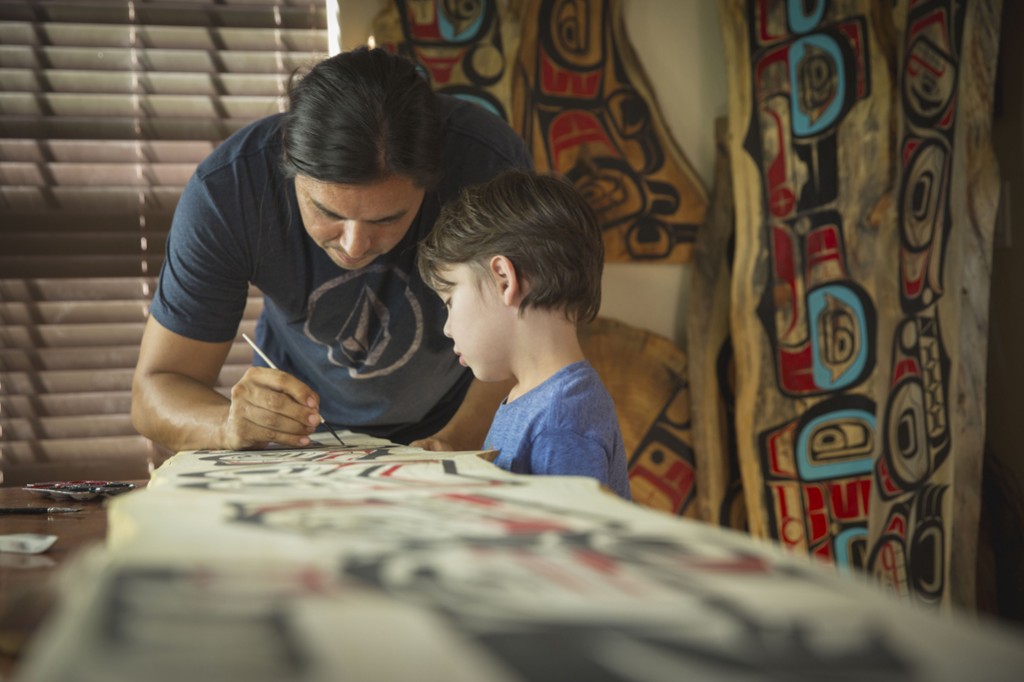
Through our relationship with N-grained, Inc we were introduced to a man of mellow charm and incredible talent. Through this interview we discovered an epic story of tradition, skill, unique challenges, and a mind-blowing legacy in progress.
This is Part 1 of our "Power to the Makers" interview with artist James Johnson.
DCS: For those who don't know, who is James Johnson?
James: I am from Juneau, Alaska. I belong to the Cha'ak Dakl'awedi Clan (Eagle/Kllerwhale). I'm an artist for N-Grained Inc, founded by Mark Landvik.
I'm a husband and a father. My son Elias is my biggest inspiration for my art. He was born with a life threatening genetic disorder called Cystic Fibrosis. When my son was born, it was heartbreaking to hear the average life expectancy of a person with CF is 39 years old. I had never cried in front of my wife until the day he was diagnosed. But, we made the decision right away to not hold Elias back from anything, we are going to give him every chance to live a full life. He requires a lot of treatments everyday, his care and his health is my main priority. Kids with CF are very resilient, they work so hard just to do what we take for granted, which is just to breathe.
Elias has taught me to value every second you get in this life, focus on what matters most. For me, it's all him.

DCS: Culture is the essence of your work. What was your upbringing like and how did you develop your skills?
James: My late father Franklin Johnson was the first person to encourage me to carry on the culture thru my artwork. He was my biggest supporter for sure when I first started.
He passed away 2 years ago, I think about my dad often when I'm painting or carving, I know he's smiling alongside me when I finish a piece. I am self-taught, which is a rare thing for art. Traditionally, the art is passed down from generation to generation but I didn't really get into Tlingit art until 8 years ago. I currently live in Phoenix, AZ, so I wasn't able to apprentice under an artist to have the knowledge passed down to me directly.
I am the first Tlingit artist in my family line. There are a lot of fundamentals and principles behind what you see visually. The form line tell stories of our culture and heritage, lines are symmetrical, sizes and widths are exact, you have to balance the positive and negative spaces, everything is very precise. I've spent a lot of time reading books about form line, studying old photographs of artwork, and looking at pieces in museums. I can't tell you how many hours I've spent carving in my garage when it's over 100 degrees in Arizona. I had to develop these fundamentals on my own through a lot of practice.
As an artist, you learn the fundamentals, but how you apply them to your art develops your style.

DCS: What does it mean to you personally to carry on the traditions of your people through your art?
James: My favorite Tlingit artist I look up is Nathan Jackson, he is all-time. In 2012, I had one of my masks selected for the Juried Art Show in Juneau, Alaska. Nathan was one of the jurors who selected my piece, and I asked him to critique my work. I was so nervous. Long story short, he told me how bad I was (haha). But, instead of getting discouraged, I used that feedback as motivation to become better.
This past year, I was able to finally meet Nathan in person. It was such an honor. I had to work hard to get to where I'm at. But, the beauty is, developing your form-line and carving is a life-long learning process, the progression is never ending. Now, everyday I do something to better my art, that's what you have to do if you want to be good.
Northwest Native art is so beautiful, I feel that this is what I'm meant to be doing with my life. That is everything to me. The artwork that I do was created hundreds of years ago by my ancestors, they created and developed this art form into what you see today. We are all creating our interpretation of it, while preserving the traditions of the culture. The art form was passed down from generation to generation.
During the late 1800's/early 1900's, a lot of the traditions were lost in all native cultures. Potlatches and ceremonies were outlawed, the language was not allowed to be spoken in schools, the onset of disease drastically reduced entire native populations, and entire villages were left abandoned. Native people suffered, and there was a generation gap where the art form suffered as well. The time period was very tragic. So, I see it as this beautiful gift was placed into my hands by my ancestors, it is my privilege to carry it through my lifetime, then pass it on to the next generation.
I'm going to make the most out of it, leave my mark long after I'm gone, and hopefully pass it on to my son Elias. I'm honored to do my part.
